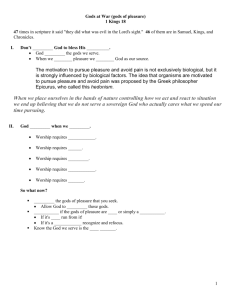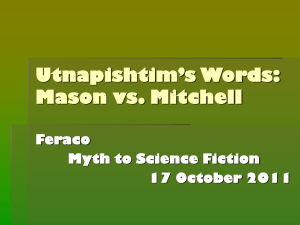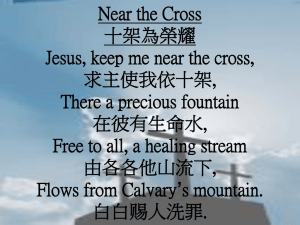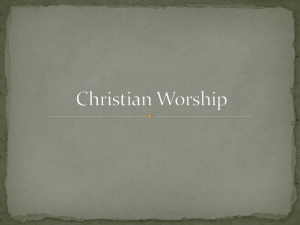Creation
advertisement
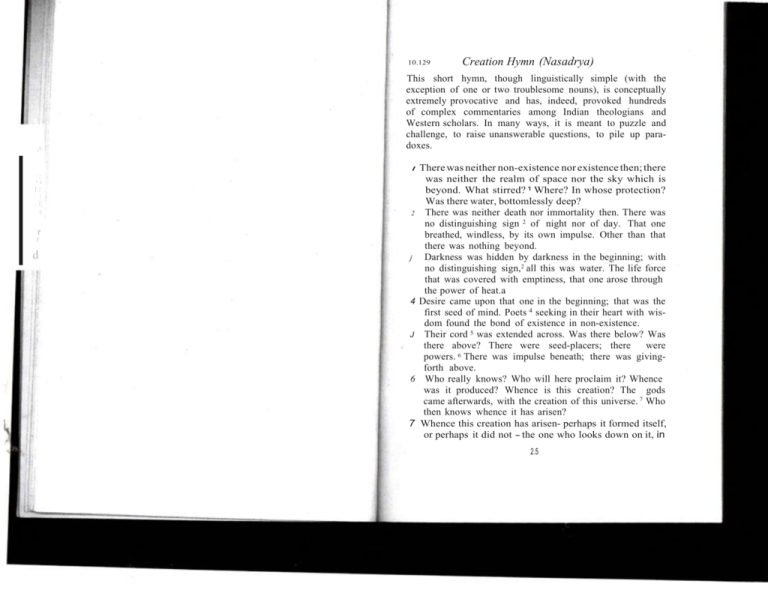
10.129
;!:
This short hymn, though linguistically simple (with the
exception of one or two troublesome nouns), is conceptually
extremely provocative and has, indeed, provoked hundreds
of complex commentaries among Indian theologians and
Western scholars. In many ways, it is meant to puzzle and
challenge, to raise unanswerable questions, to pile up paradoxes.
I
; :;
' i
rr
i
. i;
·!·
2
r
r
d
Creation Hymn (Nasadrya)
j
4
J
6
7
There was neither non-existence nor existence then; there
was neither the realm of space nor the sky which is
beyond. What stirred? 1 Where? In whose protection?
Was there water, bottomlessly deep?
There was neither death nor immortality then. There was
no distinguishing sign 2 of night nor of day. That one
breathed, windless, by its own impulse. Other than that
there was nothing beyond.
Darkness was hidden by darkness in the beginning; with
no distinguishing sign,2 all this was water. The life force
that was covered with emptiness, that one arose through
the power of heat.a
Desire came upon that one in the beginning; that was the
first seed of mind. Poets 4 seeking in their heart with wisdom found the bond of existence in non-existence.
Their cord 5 was extended across. Was there below? Was
there above? There were seed-placers; there
were
powers. 6 There was impulse beneath; there was givingforth above.
Who really knows? Who will here proclaim it? Whence
was it produced? Whence is this creation? The gods
came afterwards, with the creation of this universe. 7 Who
then knows whence it has arisen?
Whence this creation has arisen- perhaps it formed itself,
or perhaps it did not - the one who looks down on it, in
2.5
'I'HE RIG VEDA
the highest heaven, only he knows - or perhaps he does
not know.
_, . I
,'n
NOTES
.tr !
. - '.<
;. :ii,
·q i
!
•!
::i
Hl
t r:t
I. The verb is often used to describe the motion of breath. The
verse implies that the action precedes the actor.
z. That is, the difference between night and day, light or darkness, or possibly sun and moon.
3· Tapa.r designates heat, in particular the heat generated by
ritual activity and by physical mortification of the body.
4· Kavi designates a poet or saint.
5. Possibly a reference to the 'bond' mentioned in verse 4, .or
a kind of measuring cord by which the poets delimit - and hence
create - the elements.
6. Through chiasmus, the verse contrasts male seed-placers,
giving-forth, above, with female powers, impulse, below.
7· That is, the gods cannot be the source of creation since they
came after it.
xo.xu
{!
'
':
,;;·
r
The Unknown God, the Golden Embryo
This creation hymn poses questions about an unnamed god
(whom Max Muller first dubbed Deus Ignotus); later tradition
(beginning with the subsequent appending of the final verse
of this hymn, a verse that ends with a phrase used to conclude
many other Rig Veda hymns) identified this god with Prajapati and made the question in the refrain (who?) into an
answer: 'Who' (Ka) is the name of the creator, a name explicitly said, in later texts, to have been given to Prajapati
by Indra (as agnostics are sometimes accused of praying 'to
whom it may concern'). But the original force of the verse
is speculative: since the creator preceded all the known gods,I
creating them, who could he be? In verse 7, he seems to
appear after the waters; in verse 9, the waters appear from
him. They are born from one another, a common paradox.z
The creator in this hymn is called Hira.l).yagarbha, a truly
pregnant term. It is a compound noun, whose first element
z6
CREATION
means 'gold' and whose second element means 'womb,
seed, embryo, or child' in the Rig Veda and later comes to
mean 'egg'; this latter meaning becomes prominent in the
cosmogonic myth of the golden egg that separates, the two
shells becoming sky and earth, while the yolk is the sun.a
In the present hymn, the compound functions straightforwardly: the god i.r the golden embryo or seed. Later, it
is glossed as a possessive compound: he is the god who
(more anthropomorphically) po.r.re.r.re.r the golden seed or
egg. Sayat).a suggests that the compound may be interpreted
possessively even here, making it possible to include several
levels of meaning at once- 'he in whose belly the golden seed
or egg exists like an embryo'. This seed of fire is placed in
the waters of the womb; it is also the embryo with which
the waters become pregnant (v. 7). So, too, Agni is the
child of the waters but also the god who spills his seed in the
waters. These are interlocking rather than contradictory
concepts; in the late Vedas, the father is specifically identified
with the son. Furthermore, the egg is both a female image
(that which is fertilized by seed and which contains the embryo
that is like the yolk) and a male image (the testicles containing
seed). Thus the range of meanings may be seen as a continuum
of androgynous birth images: seed (male egg), womb (female
egg), embryo, child.
In the beginning the Golden Embryo arose. Once he
was born, he was the one lord of creation. He held in
place the earth and this sky. 4 Who is the god whom
we should worship with the oblation?
2 He who gives life, who gives strength, whose command
all the gods, his own, obey; his shadow is immortalityand death. 5 Who is the god whom we should worship
with the oblation?
} He who by his greatness became the one king of the
world that breathes and blinks, who rules over his twofooted and four-footed creatures - who is the god whom
we should worship with the oblation?
I
2.7
THB RIG VBDA
io!
(·1
:
"'.
4 He who through his power owns these snowy mountains,
and . the ocean together with the river Rasa, 6 they say;
who has the quarters of the sky as his two arms 7 - who is
the god whom we should worship with the oblation?
J He by whom the awesome sky and the earth were made
firm, by whom the dome of the sky was propped up, and
the sun, who measured out the middle realm of space 8 who is the god whom we should worship with the·
oblation?
6 He to whom the two opposed masses looked with
trembling in their hearts, supported by his help, 9 on
whom the rising sun shines down- who is the god whom
we should worship with the oblation?
7 When the high waters came, pregnant with the embryo
that is everything, bringing forth fire, he arose from that
as the one life's breath of the gods. Who is the god whom
we should worship with the oblation?
8 He who in his greatness looked over the waters, which
were pregnant with Dak a.10 bringing forth the sacrifice, he who was the one god among all the gods - who
is the god whom we should worship with the oblation?
. J Let him not harm us, he u who fathered the earth and
created the sky, whose laws are true, who created the
high, shining waters. Who is the god whom we should
worship with the oblation?
·ro 0 Prajapati, lord of progeny, no one but you embraces
all these creatures. Grant us the desires for which we
offer you oblation. Let us be lords of riches.
CREATION
s. This may refer to the world of gods and the world of humans,
or it may have some subtler and darker metaphysical significance.
6. The river Rasa surrounds heaven and earth, separating the
dwelling-place of men and gods from the non-space in which the
demonic powers dwell. Cf. Io. Io8.2.
7· A reference to the cosmic giant, Puru a (cf. I0.9o), whose
arms are in that part of space which the four cardinal directions
span.
8. This act of measuring out space, closely connected with the
propping apart of sky and earth {cf. v. I), is also attributed to
Vi$nU and Varu 0a, who are said to set up the sun and then to
measure out a space for him to move through, a space which (unlike sky and earth) has no finite boundaries. The sun itself also
functions both as a prop to keep sky and earth apart and as an
instrument with which to measure space. Cf. I. H·Iand I. H·3.
9· This verse presents an image on two levels. The two opposed
masses are armies, the polarized forces of gods and demons
(Asuras) who turn to the creator for help (as in 2.I2.8). But they
also represent the parted sky and earth, who seek literal 'support'
(the pillar to keep them apart). The images combine in a metaphor
suggesting that sky and earth themselves form a phalanx in the
fight between gods and demons.
Io. Dak$a represents the male principle of creation and is later
identified with Prajapati. As the embryo of the waters, he is identified with the seed or fire (v. 7), the latter then explicitly defined
in this verse as the sacrifice, or sacrificial fire. Sacrifice is often an
element in primeval creation (cf. I0.9o.6-9).
Ix. In this verse, the abstract tone vanishes and the poet lapses
back into a more typical Vedic fear (and particularly typical of
book Io), the fear of a personified, malevolent god.
10.90
NOTES
1. Cf.
Io. I 29.6.-Here and throughout these notes, numbers with-
out a designated text refer to Rig Vedic hymns translated in this
volume.
2. Cf. the birth of Dak$a and Aditi from one another in 10.72.4.
3· Cf. 1o.82.s-6.
4· This traditional cosmogonic act is often credited to Vig1u,
Varw;ta, Indra, and other gods.
28
Purufa-Siikta, or The Ifymn of Man
In this famous hymn, the gods create the world by dismembering the cosmic giant, Puru a, the primeval male who
i the victim in a Vedic sacrifice. 1 Though the theme of the
cosmic sacrifice is a widespread mythological motif, this
hymn is part of a particularly Indo-European corpus of
myths of dismemberment. 2 . The underlying concept is,
therefore, quite ancient; yet the fact that this is one of the
29

